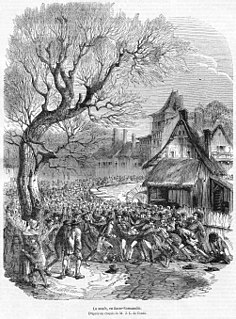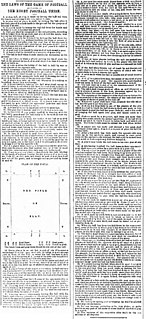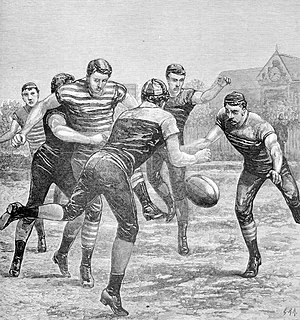 W
WThe history of rugby union follows from various football games long before the 19th century, but it was not until the middle of that century that the rules were formulated and codified. The code of football later known as rugby union can be traced to three events: the first set of written rules in 1845, the Blackheath Club's decision to leave the Football Association in 1863 and the formation of the Rugby Football Union in 1871. The code was originally known simply as "rugby football". It was not until a schism in 1895, over the payment of players, which resulted in the formation of the separate code of rugby league, that the name "rugby union" was used to differentiate the original rugby code. For most of its history, rugby was a strictly amateur football code, and the sport's administrators frequently imposed bans and restrictions on players who they viewed as professional. It was not until 1995 that rugby union was declared an "open" game, and thus professionalism was sanctioned by the code's governing body, World Rugby—then known as the International Rugby Football Board (IRFB).
 W
WThe History of the Argentina national rugby union team starts with the first international played by an Argentine side v. the British Islands in 1910 when they toured on South America. Argentina gained recognition in 1965, when the team toured South Africa playing a series of friendly matches there. In that tour the national team was nicknamed Los Pumas, a name that became an identity mark for Argentina, remaining to present days.
 W
WBarbarians v New Zealand was a 1973 rugby union match between the Barbarians and New Zealand. It was played as part of the 1972–73 New Zealand tour of Britain, Ireland, France and North America. The game is considered to be one of the best rugby union matches ever played; it featured what has been described as "the greatest try ever", scored by Gareth Edwards. The Barbarians won the game 23–11. It was also the first time New Zealand lost to the Barbarians.
 W
WAlbert (Bert) Henry Baskerville was a Wellington postal clerk, a rugby union forward, author of the book "Modern Rugby Football: New Zealand Methods; Points for the Beginner, the Player, the Spectator" and a pioneer of rugby league.
 W
WEdward Bramwell Clarke was an educator in Meiji period Japan, who is credited with introducing the sport of rugby to Japan.
 W
WComparison of association football (football/soccer) and rugby union (rugby/rugger) is possible because of the games' similarities and shared origins.
 W
WThe Reverend William Webb Ellis was an English Anglican clergyman and the supposed inventor of rugby football while a pupil at Rugby School. According to legend, Webb Ellis picked up the ball and ran with it during a school football match in 1823, thus creating the "rugby" style of play. Although the story has become firmly entrenched in the sport's folklore, it is not supported by substantive evidence, and is discounted by most rugby historians as an origin myth.
 W
WRugby Europe is the administrative body for rugby union in Europe. It was formed in 1999 to promote, develop, organise and administer the game of rugby in Europe under the authority of World Rugby. However, it is not responsible for the organisation of the Six Nations Championship or the competitions run by European Professional Club Rugby.
 W
WA field goal, also called a flying kick or speculator, was a way of scoring in the game of rugby football. It consisted of a player kicking the ball from the ground without using their hands in open play over the crossbar. This method of scoring was abolished in rugby union in 1905 and in rugby league in 1950.
 W
WThe laws of Rugby Union are defined by World Rugby and dictate how the game should be played. They are enforced by a referee, generally with the help of two assistant referees.
 W
WRugby union has a long history in New Zealand. Today, New Zealand holds tier one status with World Rugby.
 W
WThe Rugby Football League is the governing body for professional rugby league in England. The name Rugby Football League previously also referred to the main league competition run by the organisation. This has since been supplanted by Super League, the Championship and League 1.
 W
WThe oldest football clubs trace their origins to the mid-19th century, a period when football evolved from being a casual pastime to an organised mainstream sport.
 W
WThe standard modern rugby union numbering schemes have the starting players numbered from 1 to 15, and the replacements numbered 16 onwards. But rugby union players have not always been identified by individual labels, nor have the systems used always been the same.
 W
WThe rugby union match played between Scotland and England on 27 March 1871 was the world's first international rugby match and also the first international football match. The match was played at Raeburn Place, Edinburgh in front of 4,000 spectators. Scotland won the match, scoring two tries and a goal to England's single try.
 W
WThe Stanford rugby teams of 1906 to 1917 represented Stanford University as the school's only football program during those years, replacing American football with rugby union. The school had played American football from 1892 to 1905, but in 1906, concerned with the growing levels of violence in football, Stanford and other universities changed to rugby. Stanford played twelve seasons of rugby, during which it played other college teams, club teams from the United States, Canada, and Australia, as well as the New Zealand national team and Australia national team. Despite the team's success, it became clear that other schools were not adopting rugby in large numbers, and after rival California returned to football in 1915, Stanford faced a limited number of potential opponents; and after a year of playing neither sport officially due to World War I, the school returned to American football in 1919.
 W
WGinnosuke Tanaka is credited with the introduction of rugby to Japan. He was educated at the Leys School in Cambridge and then Trinity Hall, a college of Cambridge University. He introduced rugby to students at Keio University, in 1899, with the help of Edward Bramwell Clarke. Later, he pursued a career in banking.
 W
WThe Webb Ellis Rugby Football Museum is a rugby football museum in the town centre of Rugby in Warwickshire, England, near Rugby School. It takes its name from William Webb Ellis who is credited with inventing the game of Rugby football.
 W
WThe World Rugby Museum re-opened in early February 2018 in the South Stand of Twickenham Stadium formerly opened as ‘The Museum of Rugby’ in 1996. It became the World Rugby Museum in 2007. Its collection comprises over 37,000 pieces of rugby memorabilia, boots, balls, jerseys, programmes, match-tickets, books and assorted paraphernalia.